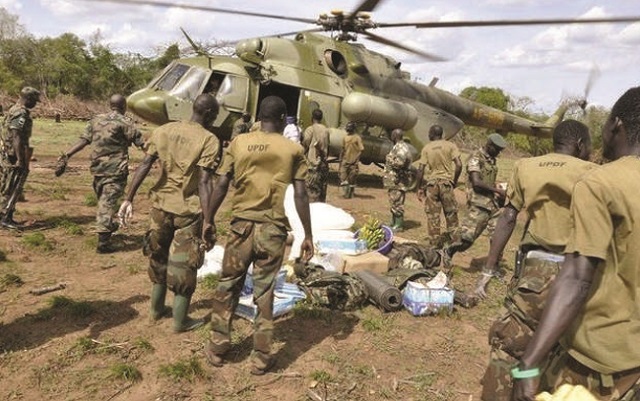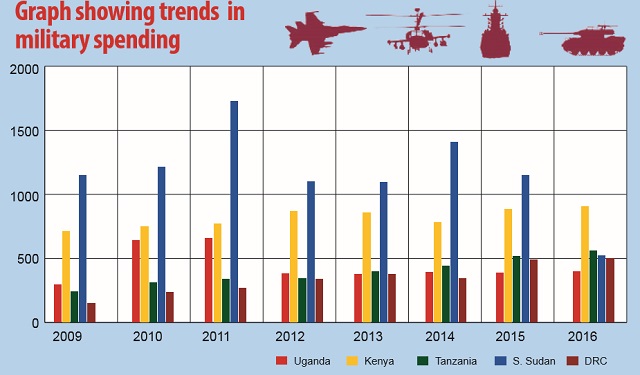
In fact, Uganda’s defence expenditure had been so aggressive that in 2011 it outspent Kenya. That year, Uganda spent US$1.02 billion; about double Kenya’s US$735 million.
Uganda spent US$270 million on its usual defense budget items (food, salaries etc) and US$ 750 million on jets pushing its officially disclosed expenditure to US$1.02 billion.
The figure could have even been much higher because some of Uganda’s military spending is classified and also the country ordered a batch of weapons—tanks and anti-tank missiles, whose cost was never declared.
At the time, competition for regional military superiority with especially Kenya, the threat of a spill-over from any feared war between Sudan and the Republic of South Sudan, and its operation in Somalia against Al Shabaab and against Joseph Kony rebels in Central Africa Republic (CAR) and the DR Congo were cited as incentives from Uganda’s ballooning military expenditure.
But what it is not buying, Uganda appears to be getting in form of donations for the Somalia mission.
Indeed, between 2015 and 2016, Uganda received from France 17 ACMAT APCs, 2 Cessna-208 Caravan Light transport aircraft, 15 Cougar APC and 5 Bell-205/UH-1 Huey-2 helicopters. All these acquisitions, the biggest being Bell Helicopters at $35 million, have been financed by the U.S. for use in Somalia.
Uganda’s mission in Somalia had for long been a double-blessing for Museveni; it kept him as a strategic ally of the U.S. in the war against terror and earned him dollars to finance his military adventures. But the situation is no longer rosy.
For instance, Defence Minister, Adolf Mwesige, recently also hinted at one of the problems Uganda is facing with the Somalia mission when he called on the government to fast-track the payment of arrears amounting to US$ 10.6m (Shs 37 billion), which is compensation of wear and tear of the equipment in line with the existing memorandum of understanding. The said arrears date as far back as 2015.
In January this year, Defence officials told the parliament’s Defence and Internal Affairs Committee that they were considering pulling out of Somalia.
The Chief of Defence Forces, Gen. David Muhoozi, said that the essential needs of UPDF soldiers in Somalia are gradually becoming costlier.
“Medication for those already based in Somalia is getting more expensive, and it is hard to fund both their travels and maintain their stay there,” he said.
Three months, later, the same noises emerged again when Defence officials appeared before the same committee to present the Defence Policy Statement, which puts the ministry’s budget at about Shs1.39 trillion.
And as military spending has dropped, so has interest in regional wars.
Experts say that globally, governments project power through their defence budgets to show that they are able to defend their countries against enemy aggression. For instance, to maintain its position as the world’s most powerful country, the U.S. spends nearly three times as much as China’s military, which is this year the second highest at $215 billion. And, at $611 billion, U.S. military spending is larger than the next eight biggest military spenders combined.
On the African continent, despite being peaceful, South Africa is always amongst the top military spenders.
It, however, appears that faced with serious cash constraints and major internal needs, Uganda can no longer enjoy the luxury of projecting power through huge military hardware acquisitions and a huge defence budget.
As a result, Uganda’s military spending has been on a downward spiral since 2012 and is now dwarfed by regional peers.
Tanzania surpassed Uganda in 2013 and in 2014, and DR Congo has also followed. Uganda’s military spending hit the lowest level in 2013 and has mostly stagnated at under $400 million.
Regional peers are not only beating Uganda at mainstream allocations to Defence—soldiers salaries, food and things like that, they are also aggressively acquiring weapons.
For instance, on top of its $933 million budget, Kenya has been restlessly looking to make bigger acquisitions in what experts say is a bid to improve capabilities against terrorists.
In the last two years, Kenya made major military equipment purchases from China, Serbia, South Africa, and Russia.
On top of these, from the United States, Kenya got 1 Cessna-208 Caravan Light transport aircraft in 2016 as aid for surveillance. It also got 2 ScanEagle UAV in a 2016 $9.9m deal. Kenya also got 8 Bell-205/UH-1 Huey-2 Helicopter in 2016.
The crown of all deals for Kenya, however, would have been an acquisition of twelve Air Tractor AT-802L, other weapons and technical support. But the deal worth up to $418 million fell through after a US congressman asked for it to be halted while allegations of faulty contracting practices, fraud, and unfair treatment are investigated.
Neighbouring Tanzania, on its part, acquired 20 warships from China in 2015. Two of the ships supplied by China’s Poly Technologies were commissioned last year.
Tanzania had the year before got several self-propelled mortars, tanks and two Haiqing Patrol craft from China.
Reports indicate that China also sold to Tanzania 24 amphibious tanks, FB-6A mobile short-range air defence systems and some multiple rocket launchers.
Tanzania had in the past also received from China 30 Type-59G tanks, 14 F-7MG fighter aircraft, six K-8 trainer jets, ten WZ-551 armoured personnel carriers, 100 FN-6 surface-to-air missiles and ten Type-63A light tanks.
In 2015, DR Congo acquired 10 APCs from Azerbaijan, 20 Towed guns from Bulgaria. DR Congo also acquired from Ukraine 50 T-64A Tanks modernized to T-64B1M in a $10 m deal.

****
 The Independent Uganda: You get the Truth we Pay the Price
The Independent Uganda: You get the Truth we Pay the Price




This is typical characteristic of the culture of vicious poverty and backwardness in Africa. Instead spending on quality education, health Agriculture (productive sector) and HONESTY to avert conflict; impoverished African states spend the bulk of meager national resources on conflict infrastructure and equipment.
E.g., there are more AK47 and machine guns in their defense armory than the rudimentary farm implements, like hoes, shovels, axe and pangas at households. There are more tanks and armored personnel carrier than tractors and crop harvesters.
There are more decorated false Generals than Veterinary doctors and crop scientists; etc.
@ Raymond
You are very right, can you get us comparative figures for USA, RUSSIA, UK, CHINA and North Korea in the in the same erea?